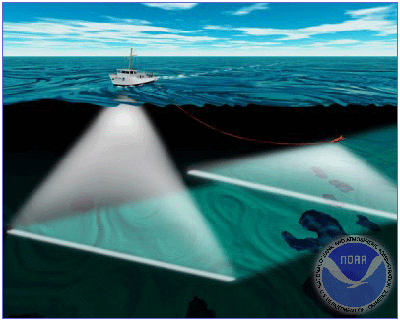 |
|
|||||||||||||||||||||||||||||||
 |
|
Hull-mounted multibeam sonar (left) |
Side scan sonar is a specialized sonar (SOund NAvigation and Ranging) system for searching and detecting objects on the seafloor. Like other sonars, a side scan transmits sound energy and analyzes the return signal (echo) that has bounced off the seafloor or other objects. In a side scan the transmitted energy is formed into the shape of a fan that sweeps the seafloor from directly under the towfish to either side, typically to a distance of 100 meters. The strength of the return echo is continuously recorded creating a "picture" of the ocean bottom where objects that protrude from the bottom create a dark image (strong return) and shadows from these objects are light areas (little or no return). While the shape of the seafloor and objects on it can be well- depicted, most side scan systems can not provide any depth information.
For more information on the operation of side scan sonar click on this site maintained by Klein Sonar.
 |
|
Side Scan Sonar Image of the Monitor
|
Multibeam sonar systems provide fanshaped coverage of the seafloor similar to side scan sonars, but the output data is in the form of depths rather than images. Instead of continuously recording the strength of the return echo, the multibeam system measures and records the time for the acoustic signal to travel from the transmitter (transducer) to the seafloor (or object) and back to the receiver. Multibeam sonars are generally attached to a vessel, rather than being towed like a side scan. Therefore, the coverage area on the seafloor is dependent on the depth of the water, typically two to four times the water depth.
 |
|
Gridded Multibeam Sonar Depths in the Approaches to New York Harbor
|
Search patterns usually are run as a series of parallel lines that ensure overlapping coverage of the sidescan or multibeam sonar. Undercertain circumstances 200% coverage is obtained by running a second search pattern perpendicular to the first over the same area.
The NOAA Ship RUDE used both of these systems in surveying the TWA Flight 800 crash site south of Moriches Bay, New York.Questions?
Call: 301-713-2653 Ext. 152
e-mail: HSD.Inquiries@noaa.gov
|
|||||||||||||||||||||||||||||||||||||
Revised Monday April 15 2002 by OCS Webmaster

